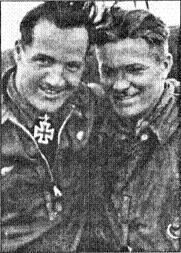Years of service 1928–42 Commands held II. Gruppe StG 1 Unit Sturzkampfgeschwader 1 | Rank Oberstleutnant Name Johann Zemsky | |
 | ||
Allegiance First Austrian Republic (to 1938)
Nazi Germany Battles/wars World War II
Operation Barbarossa
Battle of Stalingrad † Died August 28, 1942, Volgograd, Russia Awards Knight's Cross of the Iron Cross Battles and wars World War II, Operation Barbarossa, Battle of Stalingrad Service/branch Austrian Armed Forces (1928–1938), Luftwaffe (1938–1942) | ||
Johann Raimund Zemsky (11 April 1909 – 28 August 1942) was a highly decorated Major in the Luftwaffe during World War II, and one of only 882 recipients of the Knight's Cross of the Iron Cross with Oak Leaves. The Knight's Cross of the Iron Cross and its higher grade Oak Leaves was awarded to recognise extreme battlefield bravery or successful military leadership. Johann Zemsky was killed on 28 August 1942 after being shot down during the Battle of Stalingrad. He was posthumously awarded the Oak Leaves to his Knight's Cross on 3 September 1942.
Contents
Youth and early Career
Johann Zemsky joined the Austrian Army in 1928 after graduation from "Bundeserziehungsanstalt in Wien", Wien-Breitensee, one of the successor schools of the Imperial Austrian Corps of Cadets. In that year, there were no vacancies for officer training, so he became an enlisted soldier. He served with a Viennese Artillery Unit (Wiener Artillerie-Abteilung) and was promoted to Corporal (Korporal) in 1930 and Sergeant of Artillery (Feuerwerker) in 1934. An airplane enthusiast since boyhood, he took private flying lessons and -secretly - took a second job to pay for his hobby. He was later selected from the ranks for officer training, an absolute rarity in the very class conscious Austrian Armed Forces, and graduated from Theresianischen Militarakademie in 1936.
Career in the German Wehrmacht
After the German Annexation of Austria in March 1938, Zemsky tried to leave the country, but as an active officer was refused a passport and had to stay. He was transferred to the Luftwaffe (Airforce) and promoted to 1st Lieutenant. After re-training on several German aircraft types, he qualified as a flight instructor and was transferred to dive-bomber and ground attack school (Stukaschule) Insterburg/ Eastern Prussia. Due to his patient teaching style and his fairness, Zemsky was very well liked by his student pilots. His superiors disagreed with his not very formal ways, but respected the quality of pilots he produced. After the beginning of World War II, Zemsky got bored with teaching and repeatedly asked for transfer to a frontline wing, but his requests were denied because of his qualities as an instructor. The buildup for the Battle of France resulted in him finally getting an appointment as a pilot with the battle hardened I./St.G. (Stukageschwader) 76. During the Campaign in the West (Westfeldzug), Zemsky won both Iron Crosses and proved to be an able and daring leader. On 01Sep40, he was promoted to Captain (Hauptmann) and was appointed commanding officer II/St.G 1. Transferred to the Eastern Front, he fought from day one of Operation Barbarossa. After having experienced the enormous spaces of Russia and the masses of Red Army troops the Soviet Union could muster, Zemsky became very pessimistic about the chances of Germany winning the war. On 04Feb42, after 300 combat missions, he was awarded the Knights Cross off the Iron Cross. In July 1942, during the summer battles for Stalingrad, he celebrated his 500th combat mission.
Death
During his 601st mission on 28 August 1942, Zemsky's Stuka was hit by Flak and started to burn. He remained at the controls until his gunner had bailed out safely and then jumped himself. Unfortunately, he was already to low, so his parachute chute did not open completely. Still alive, when German infantry of a unit nearby who had rushed to help, reached him, Zemsky died of his injuries. His friend and gunner survived. He was mourned for by his men and buried with full military honours near the still existing Obliskaya Orthodox Church. On 03Sep42, he was posthumously promoted to Major and awarded the 117th Oak Leaves (Knight's Cross of the Iron Cross with Oak Leaves).
